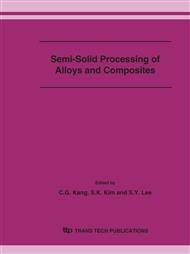p.1
p.9
p.16
p.24
p.34
p.44
p.54
p.58
p.64
Experimental Determination of the Parameters for Modelling Semi-Solid Processing
Abstract:
The numerical modeling of semi-solid processing requires data on the rheological properties of materials. This data is often obtained by rheometry but there are difficulties with characterizing high solid fractions, where the torque which can be exerted with the rheometer is insufficient. A number of other methods for measuring the flow parameters, including compression between platens, have been utilized. The various methods will be reviewed in this paper. Computational fluid dynamics modelers have often used data from steady state experiments but it is the behaviour during rapid transients which is more relevant to the actual semi-solid processing route.
Info:
Periodical:
Pages:
16-23
Citation:
Online since:
October 2006
Authors:
Price:
Сopyright:
© 2006 Trans Tech Publications Ltd. All Rights Reserved
Share:
Citation:


